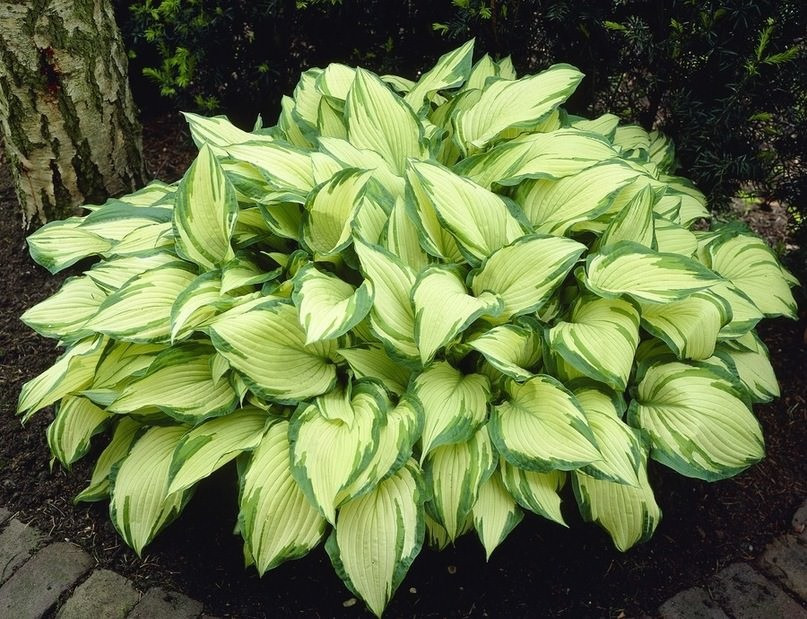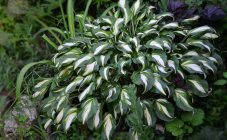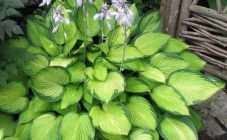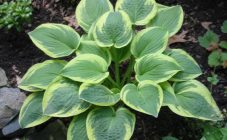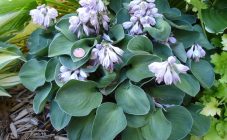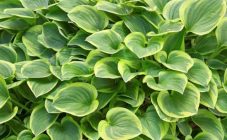The herbaceous medium-sized host Albopikta is a popular ornamental crop and is intended to cover shady areas of a garden or summer cottage. Thanks to the spectacular contrasting combination of exotic green leaves and modest inflorescences, the plant is very popular among experienced and novice flower growers.
History
Hosta Fortunei Albopicta has the Latin name "Hosta fortunei Albopicta" in all botanical reference books. The plant became famous in Europe in the 19th century and bears the name of the famous Austrian botanist - Khosta Nikolaus, who studied this flower. Hosta's second name is funkia, given in honor of the famous German botanist Heinrich Funk. It is still unknown who originally described this plant.
At first, the hosta fortunei albopicta grew only in botanical gardens, after a few years it added to the private collections of breeders. Currently, all new varieties of this very ornamental plant appear. The plant belongs to the Asparagus family. Although earlier he was included in the Lilia family.
Plant characteristics
Botanical description Host Albopicta:
- Herbaceous ornamental plant, from 40 to 70 cm in height, grows in width to 60-80 cm in diameter.
- Glossy leaves are slightly wavy, initially painted in a yellow-green hue with a darker edging around the edges. By the end of summer, the color of the color becomes more uniform and changes to a dull green.
- Flowers in the form of bells, collected in pale purple inflorescences, are located on tall pedicels, from 60 to 70 cm in height. Flowering begins in July and continues until the end of summer.
It is an unpretentious and shade-tolerant plant that can grow both in sunny areas and in the shade.
The flower of the host fortunei albopicta has become popular for its lush clumps of green foliage that can become a real gem in any landscape arrangement. The plant belongs to perennial crops and has the following characteristics:
- Unpretentious frost-resistant plant.
- The plant is undemanding to light. The host can be grown anywhere in the garden, but in semi-shady areas the plant achieves maximum decorativeness. Different amounts of light affect the color intensity of the foliage in different ways. For example, in shaded areas, the leaves acquire a rich yellow hue, in more sunny areas - a lighter tone.
- After flowering, in place of the inflorescences, seed pods are formed, filled with many flat-shaped seeds of black shades.
The flower grows rapidly and reaches its maximum decorative effect after a few years, after a huge head of lush foliage has formed, and the intensity of the color shades of the leaves will be maximum.
Planting and leaving
Successful cultivation of Fortune albopicta hosts depends on the creation of the necessary growing conditions:
- Soil selection. The plant does not require any special soil compositions, however, it prefers light loams with a lot of humus and sufficient moisture. If the plot is damp or swampy, then it is considered unsuitable for growing hosts. Lean soils are improved by adding humus, sand and mineral fertilizers. Sandy soils slow down plant growth, although they have a positive effect on the intensity of the color of the leaves.
- Watering. Timely and sufficient watering is important for the plant, especially in dry summers. It is recommended to water the hosta right under the bush, trying not to get on the leaves.If the tips of the leaves of a plant have darkened, then this is a signal of a lack of water.
The hosta planting material can be purchased at specialized garden stores or online stores. Saplings are planted in the following order:
- First, planting holes are formed, with a depth of 20 to 25 cm. Since the roots form a surface system and grow in breadth, the planting hole should be spacious and deep.
- The well is filled with a fertile earthen mixture with the addition of mineral fertilizers: ammonium nitrate, superphosphate and potassium sulfate, taken in equal proportions.
- If the soil is clayey, and water stagnation is possible, then to solve this problem, it is necessary to lay a drainage layer of old broken brick or crushed stone on the bottom of the planting pit.
- The plant is planted in such a way that there are no voids around the root collar. The seedling is mulched with a layer of leaves or peat, such an organic mulch protects the plant roots well from the evaporation of life-giving moisture and serves as an additional feed with useful microelements.
The plant is transplanted in late spring, when sharp tips of green shoots appear from the ground, or in early autumn. If a summer transplant of an adult bush is required, it is better to transplant the plant along with an earthen clod.
Caring for a plant is not much different from standard rules: timely weeding, watering and feeding are the main components of a successful plant growth. Hosta Fortchuna albopicta grows very slowly, the first two years the plant is still small, it looks like the original variety, the leaves do not have a specific color characteristic of an adult plant. Only in the third year after planting, the varietal texture and color of the leaves are formed, and the plant takes on a standard varietal appearance.
Advantages and disadvantages of the variety
There are more than 70 varieties of hosts. Of all this variety, the host Albopikta stands out for its successful combination of decorativeness and unpretentiousness. The main advantages of the plant:
- The possibility of landing in a shady and low-lying area of a garden or summer cottage.
- Good compatibility with all types of deciduous and coniferous crops.
- Change of the original color of the leaves to a solid green color by the end of flowering.
If we compare the Fortune hostu with other varieties, the following disadvantages should be noted:
- Monochromatic bloom in the form of lavender bells.
- Average plant height.
The luxurious curtain of the adult hosta Albopikta will become a real decoration of any flower garden and can turn even a modest garden plot into a dream garden.
